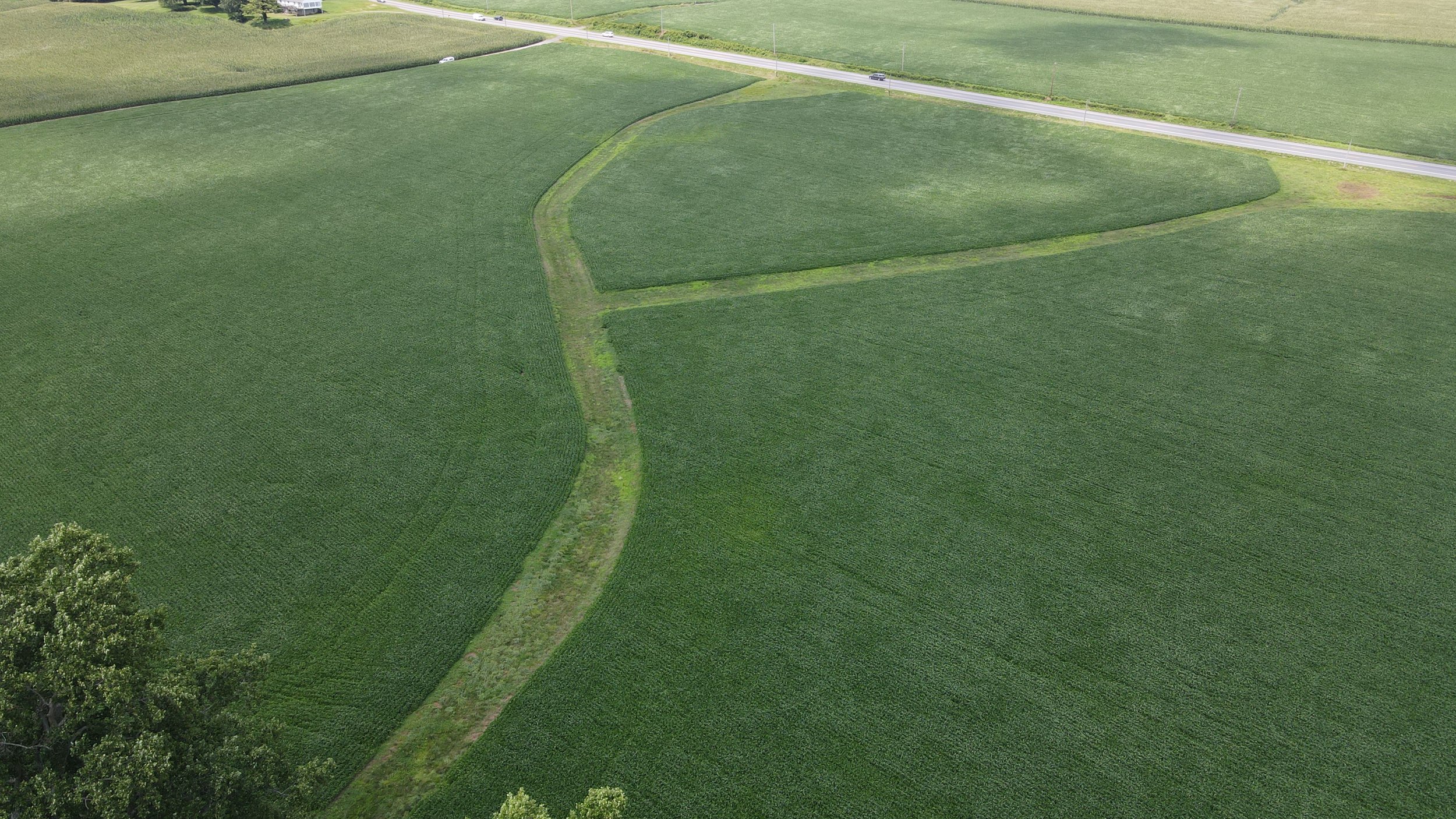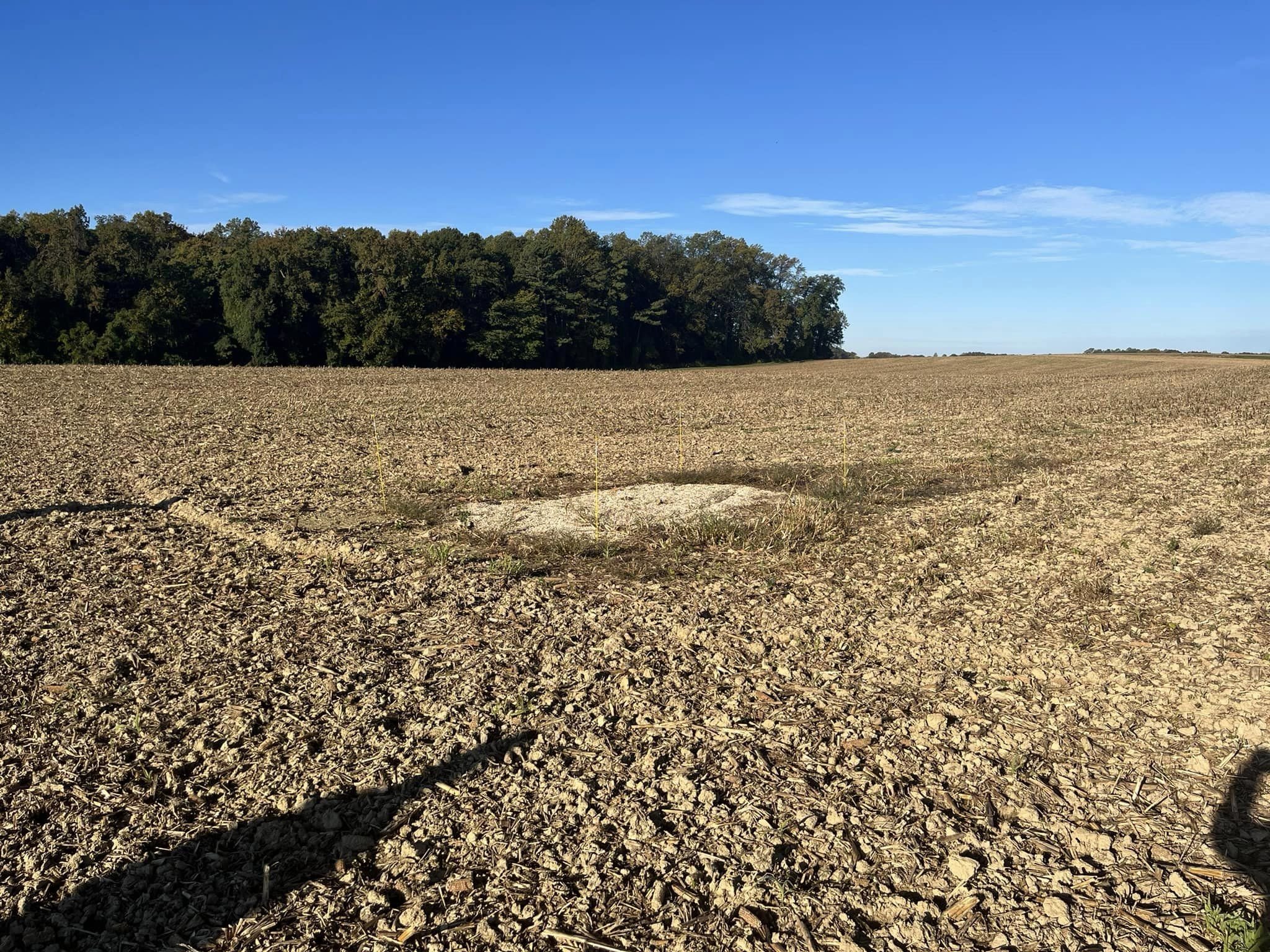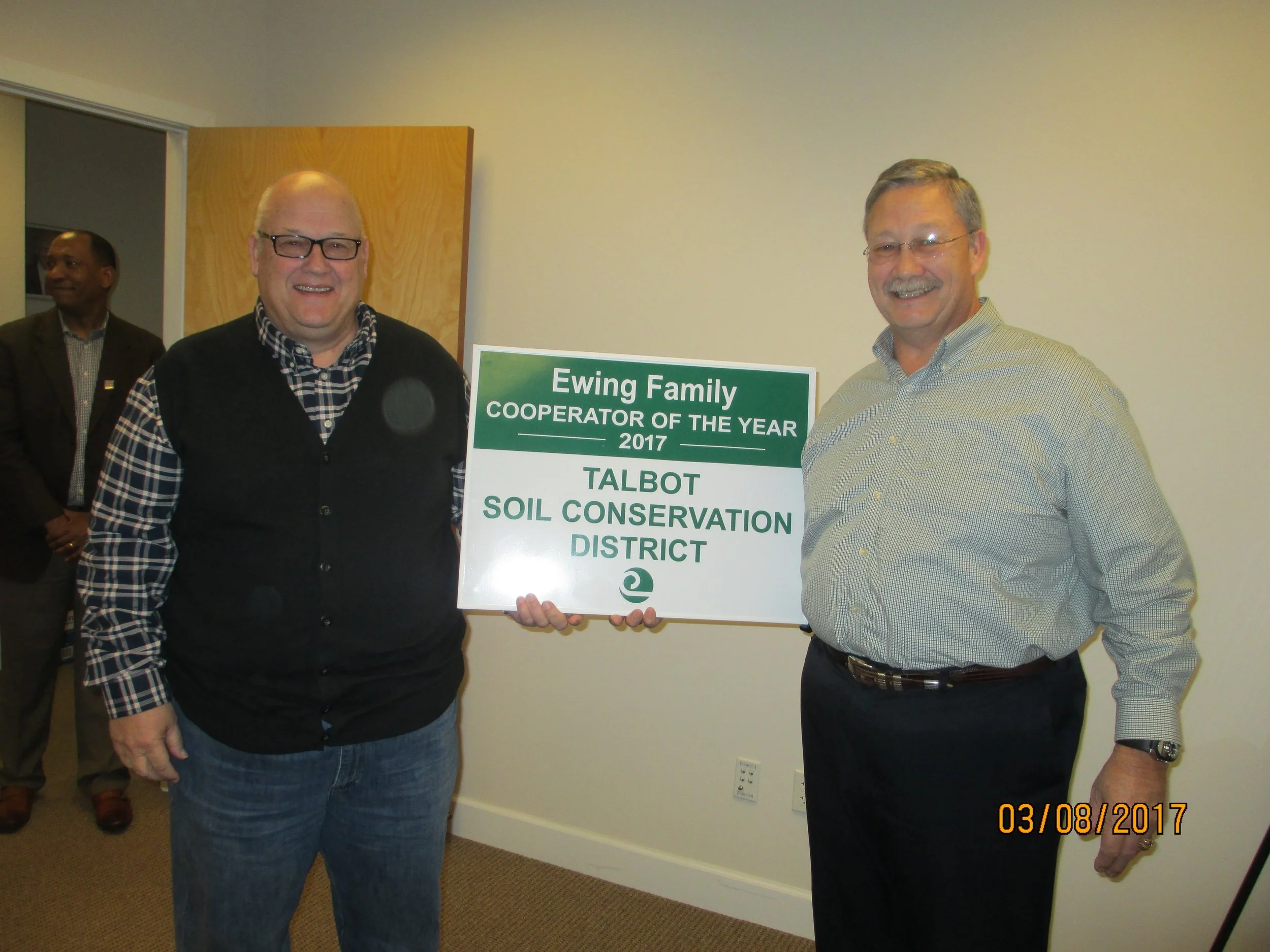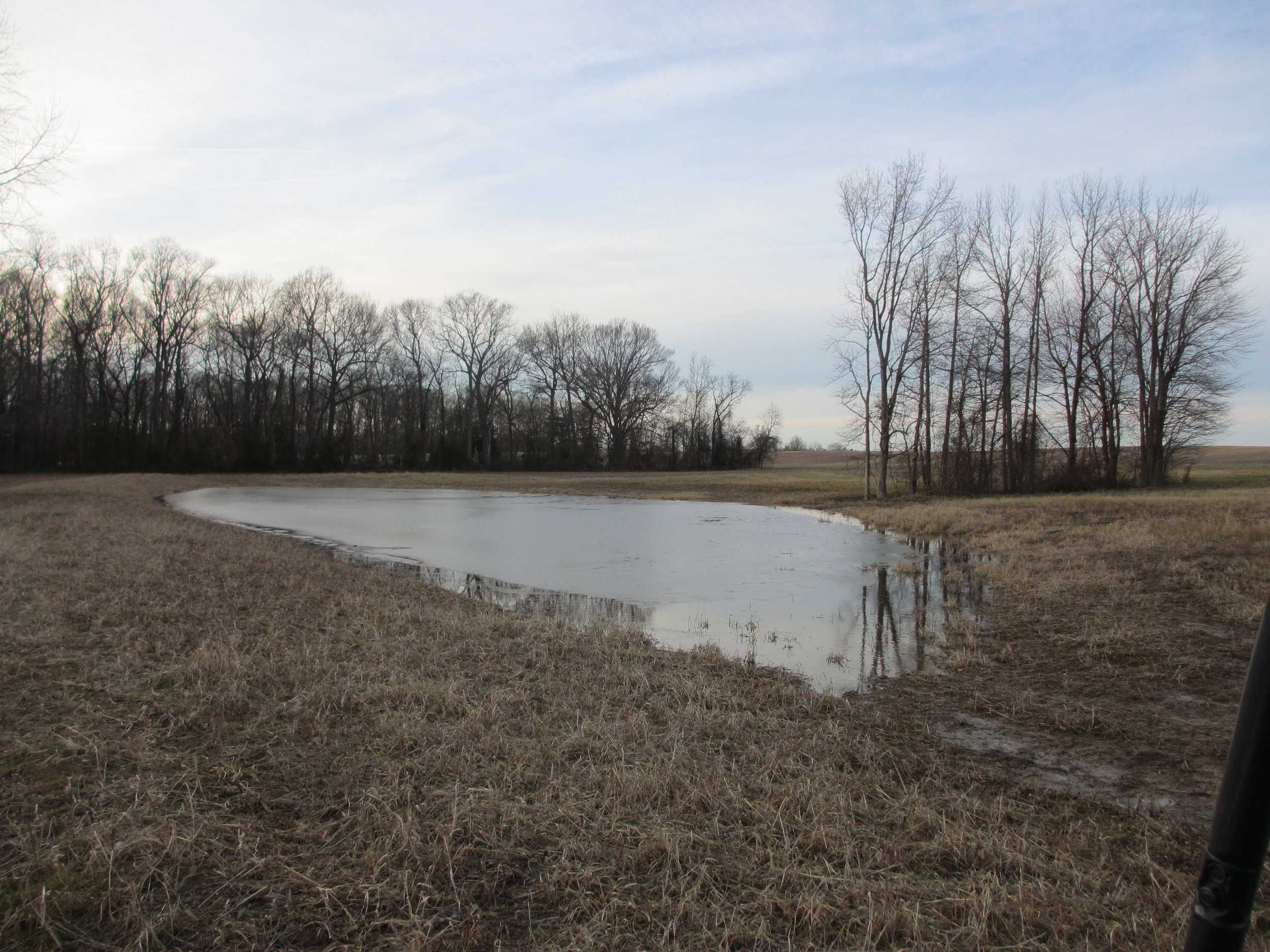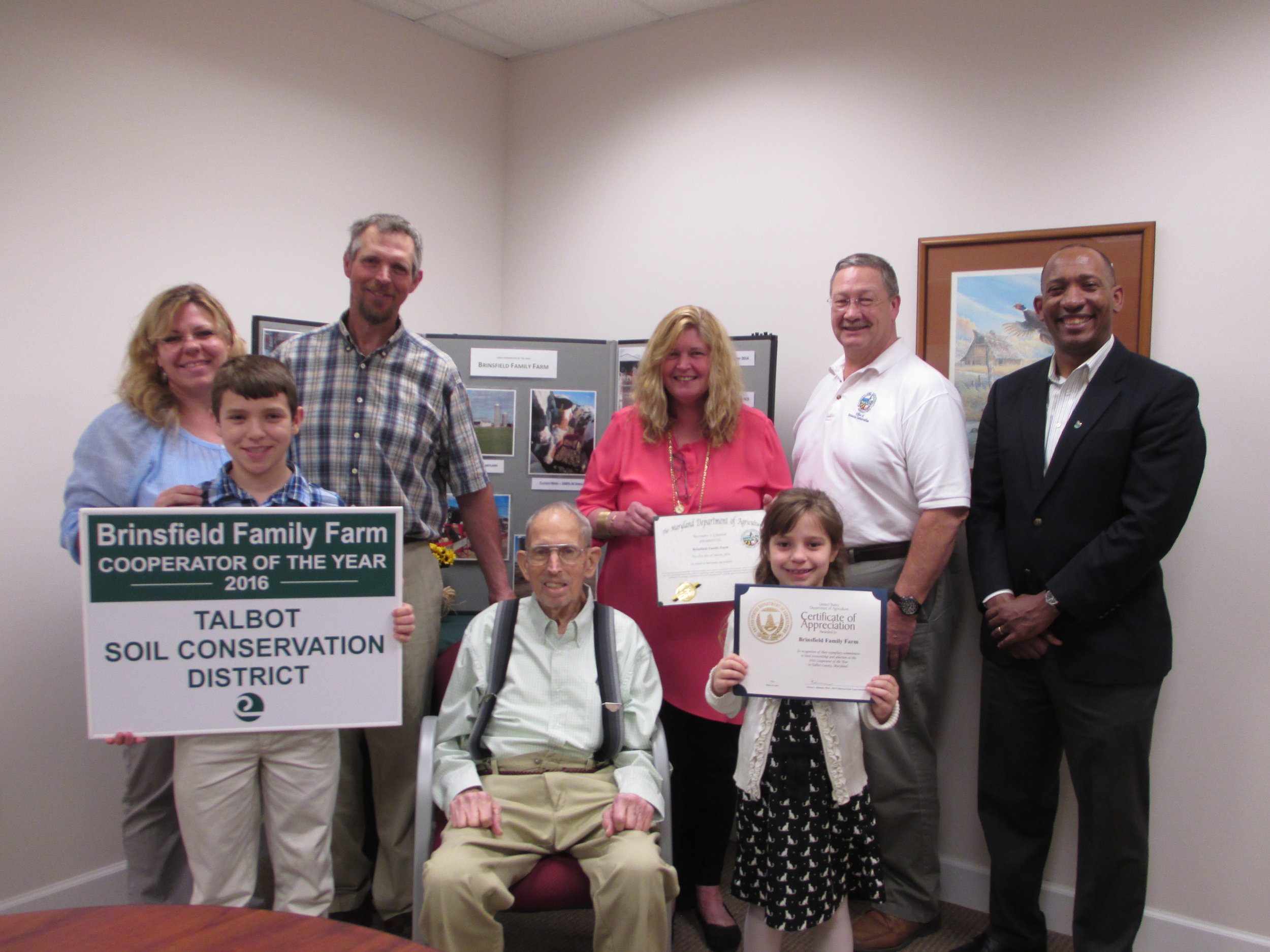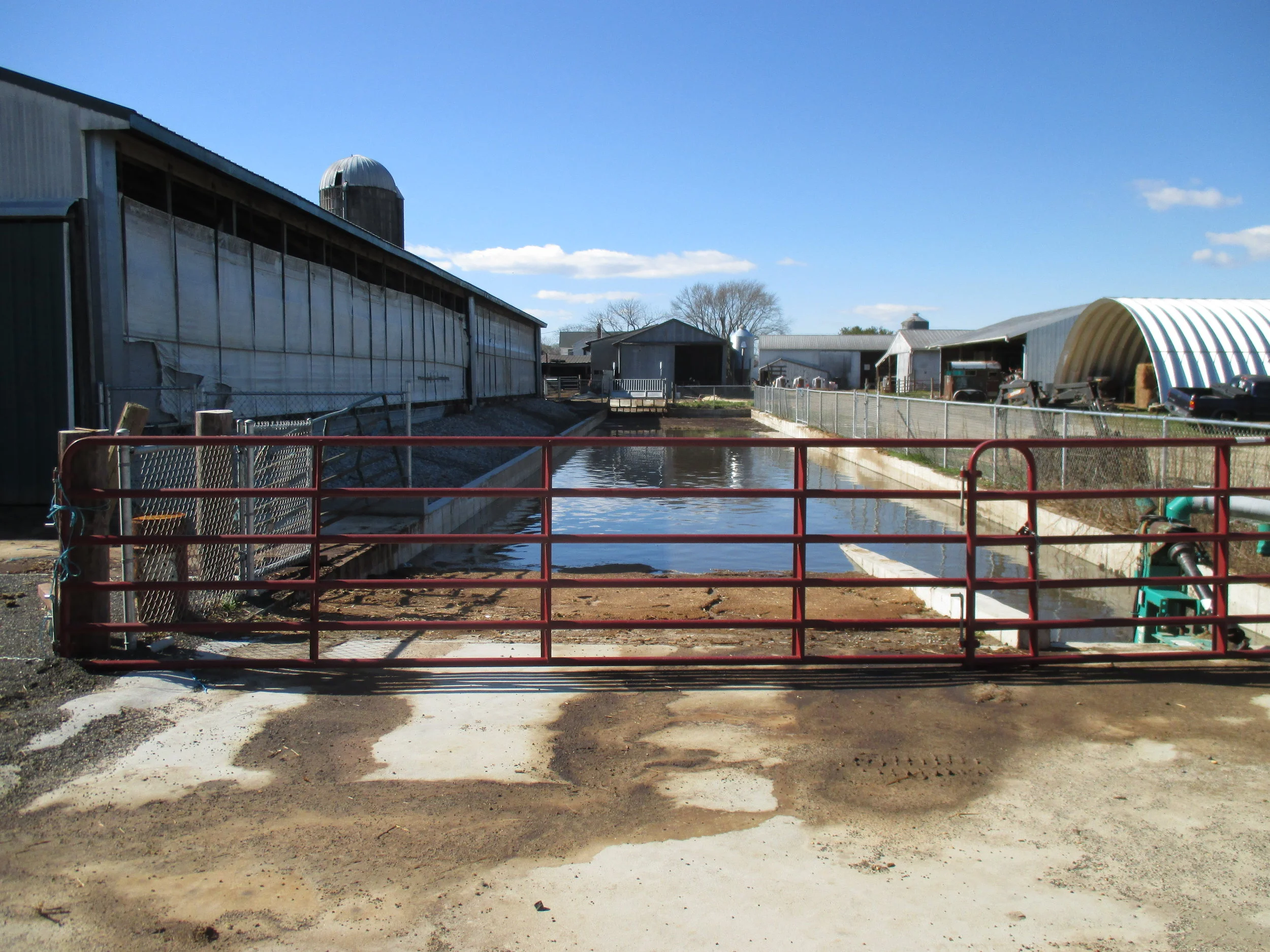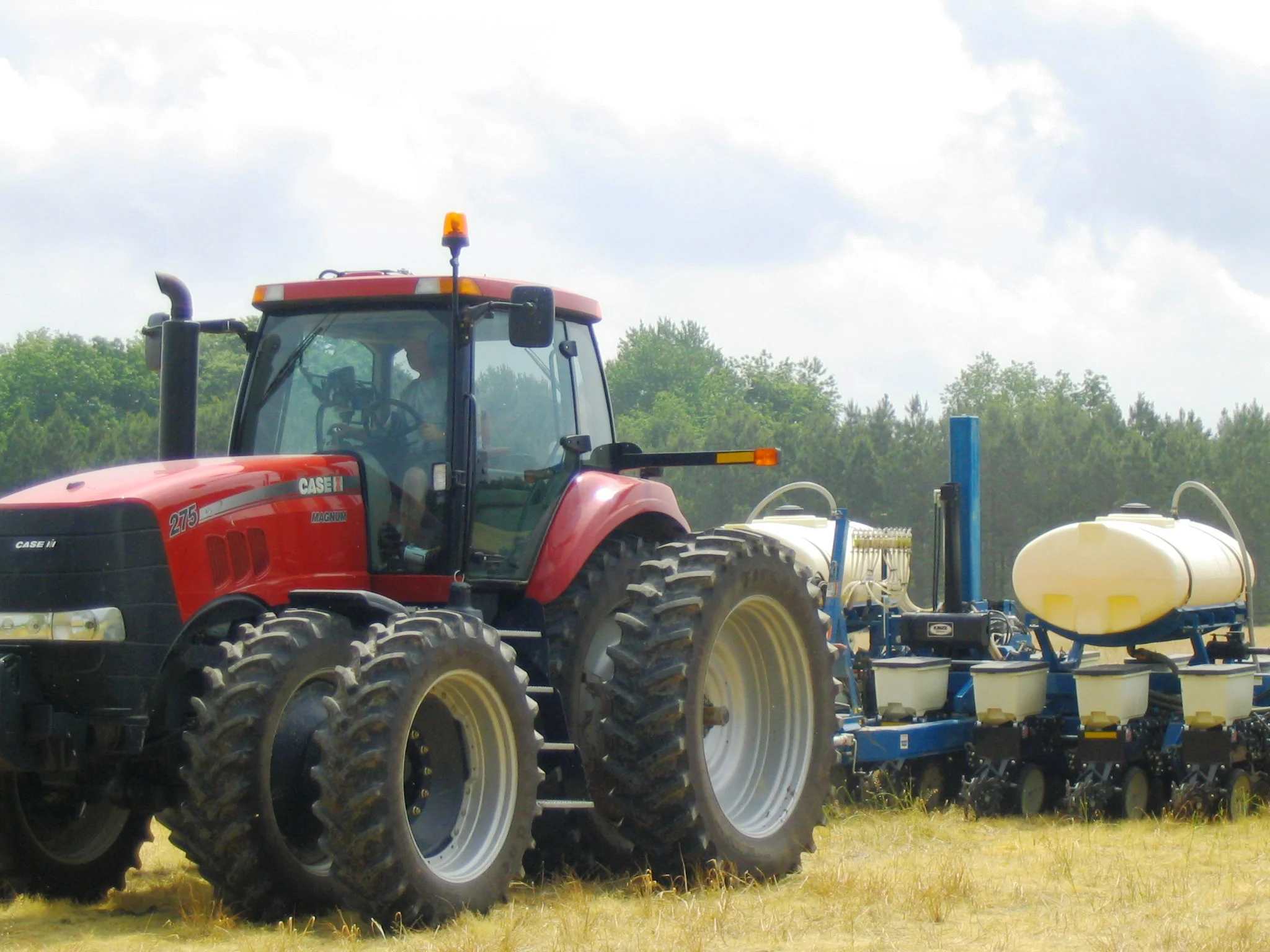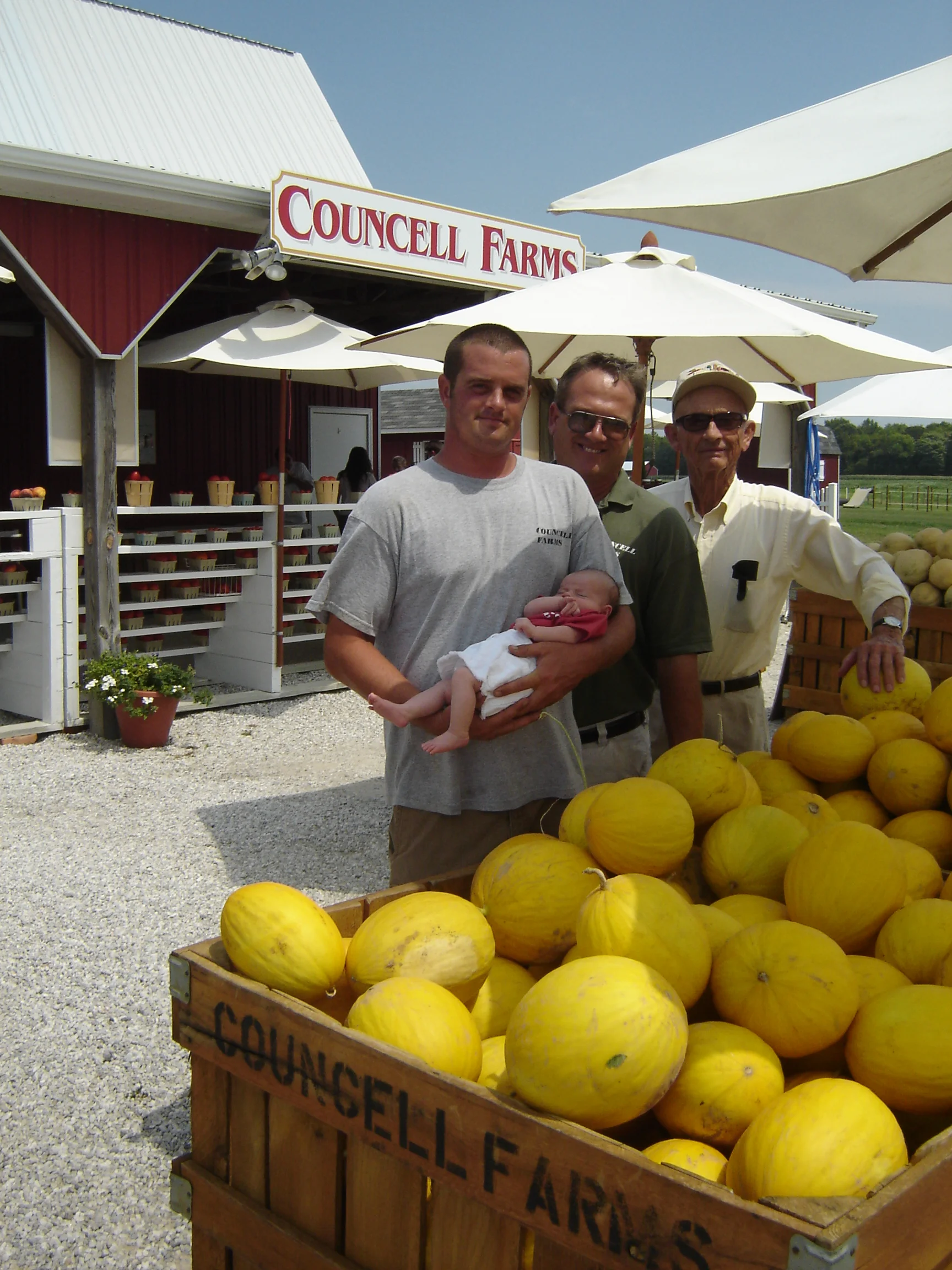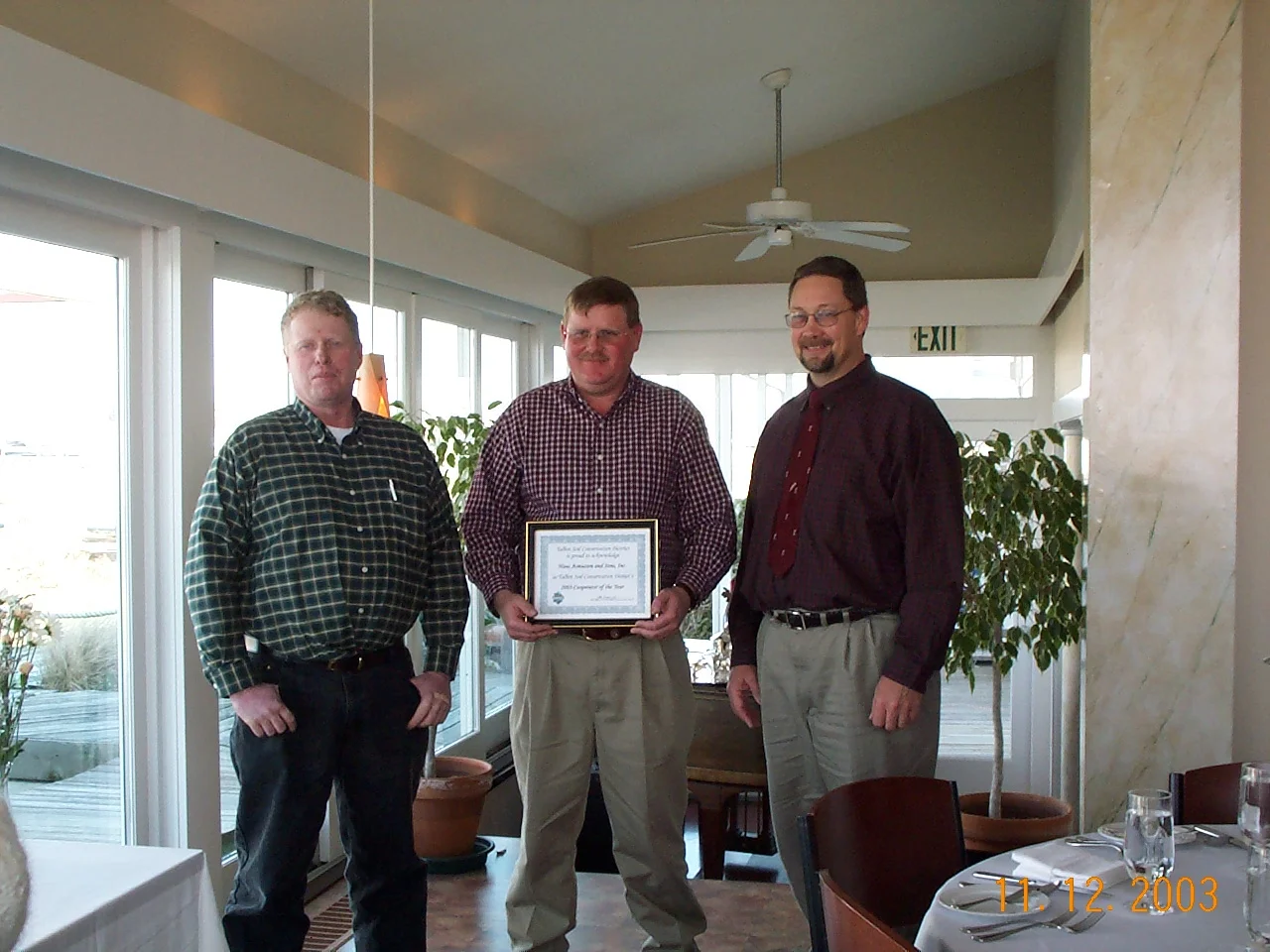|
John Trax and Keith Shortall partner in a farming operation in Easton, Maryland and have been longstanding cooperators with the Talbot Soil Conservation District. John Trax owns approximately 409.0 acres, of which 279.4 are tillable. The Trax/Shortall families have been farming together for over 60 years.
They have recently worked with the district on a number of projects to address water quality and nutrient runoff, including two grassed waterways and blind inlet, which were completed in the fall of 2022.
Mr. Trax and Mr. Shortall are pillars of the agricultural and conservation community in Talbot County, and are deserving of being named the Talbot Soil Conservation District’s 2022 Cooperator of the Year.
An established grassed waterway, built in 2010, on Dover Heights Farm just outside of Easton.
Completed in 2022, this blind inlet is able to drain excess surface water from the field while also preventing sediments and nutrients from leaving the field.
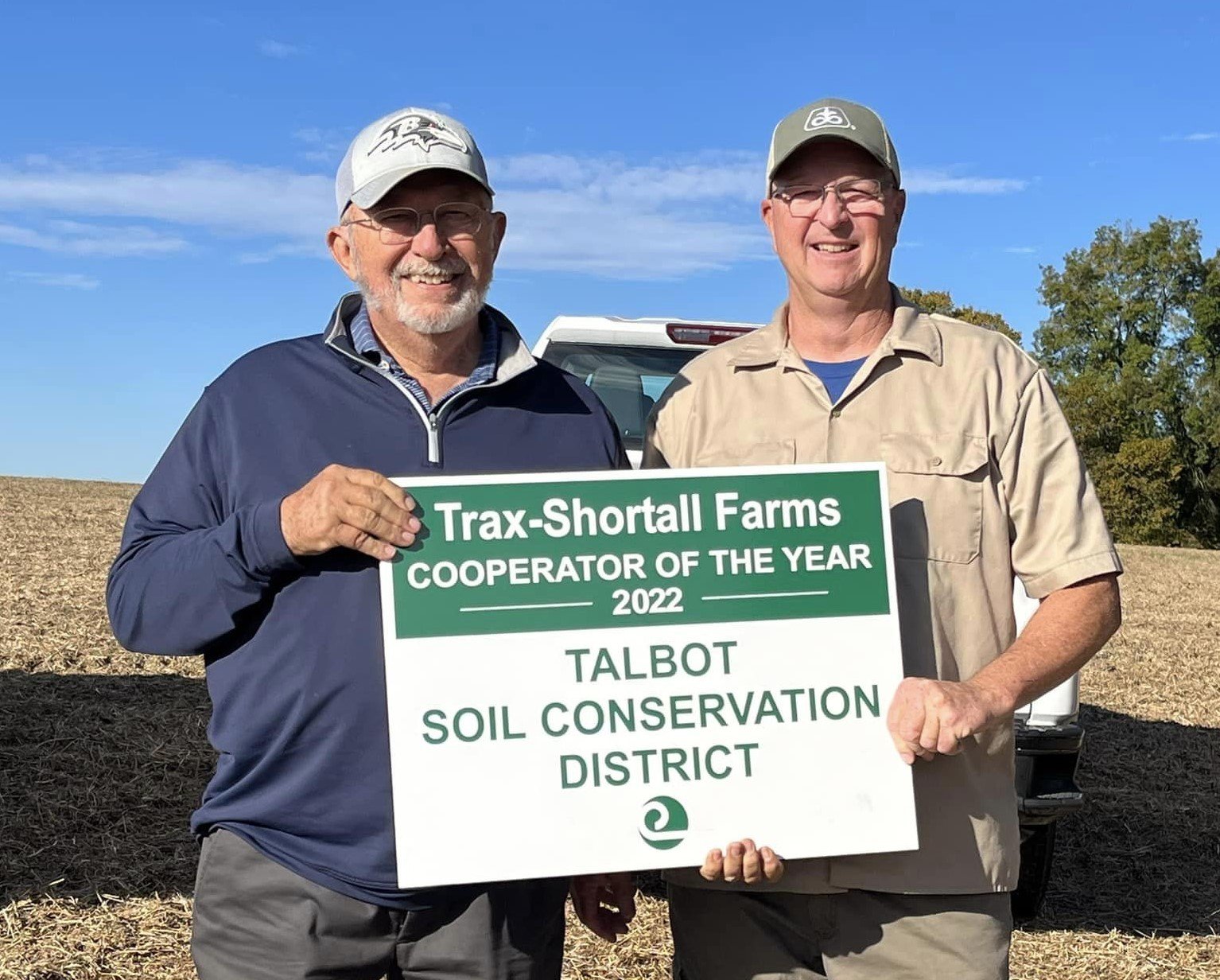
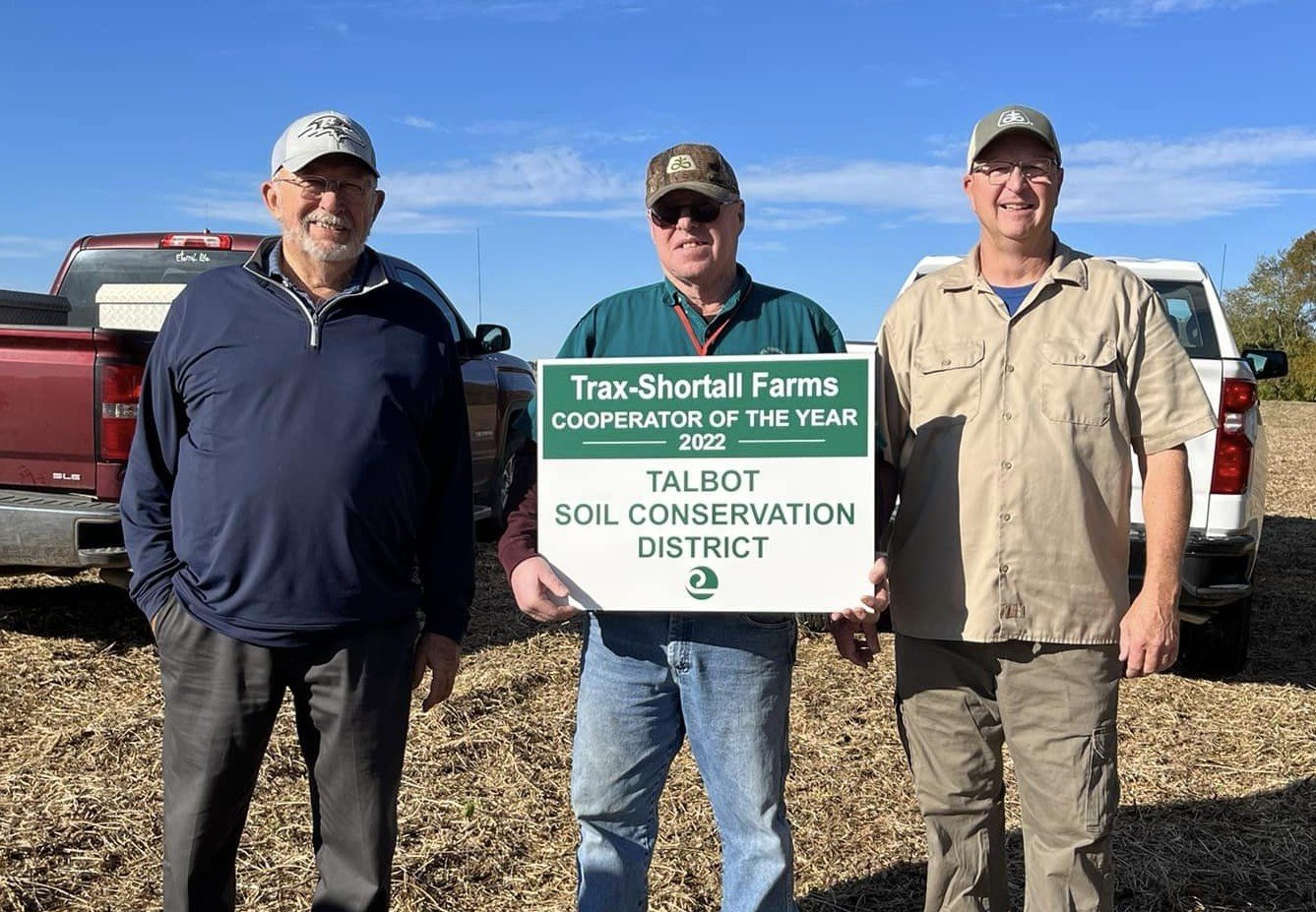
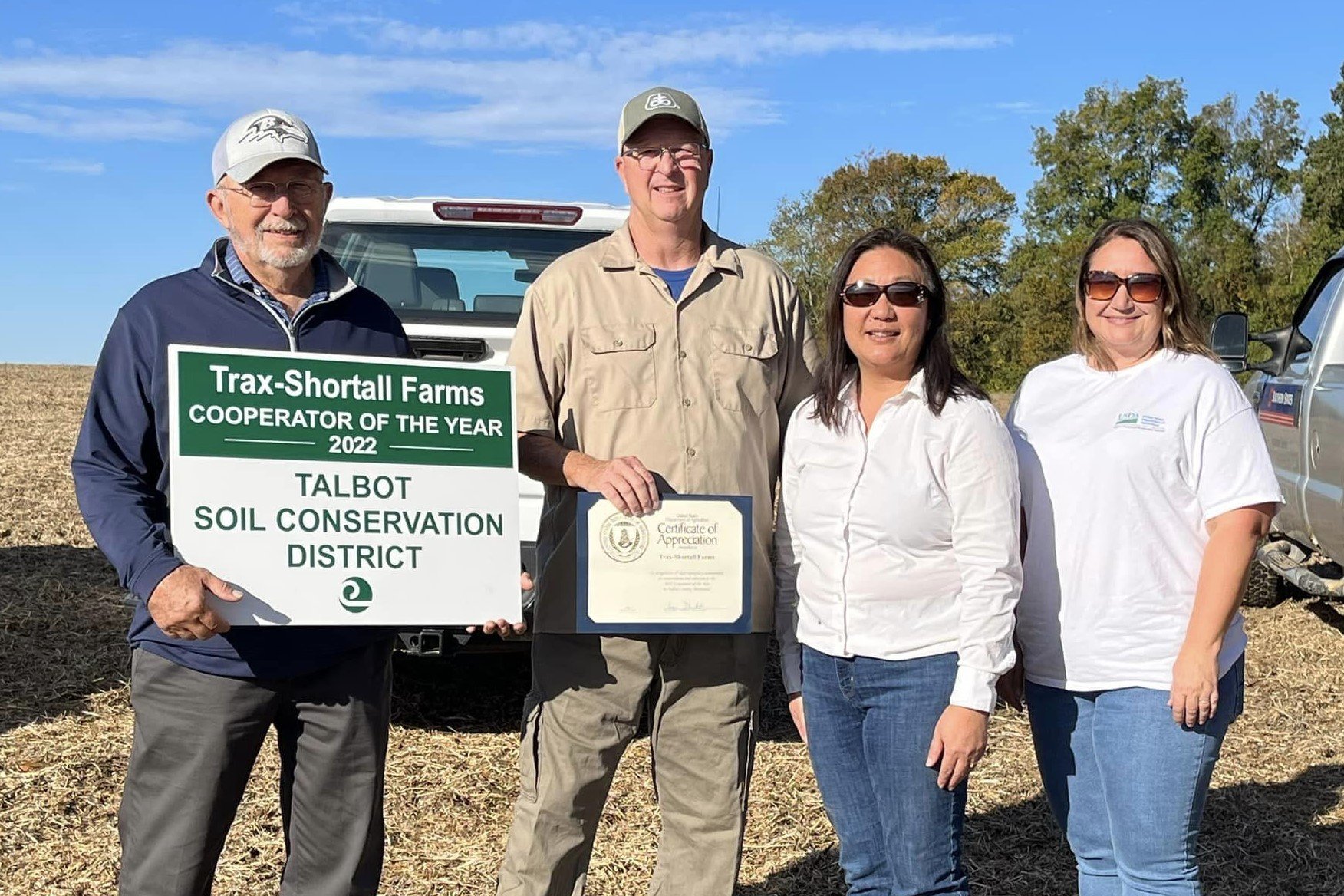

|

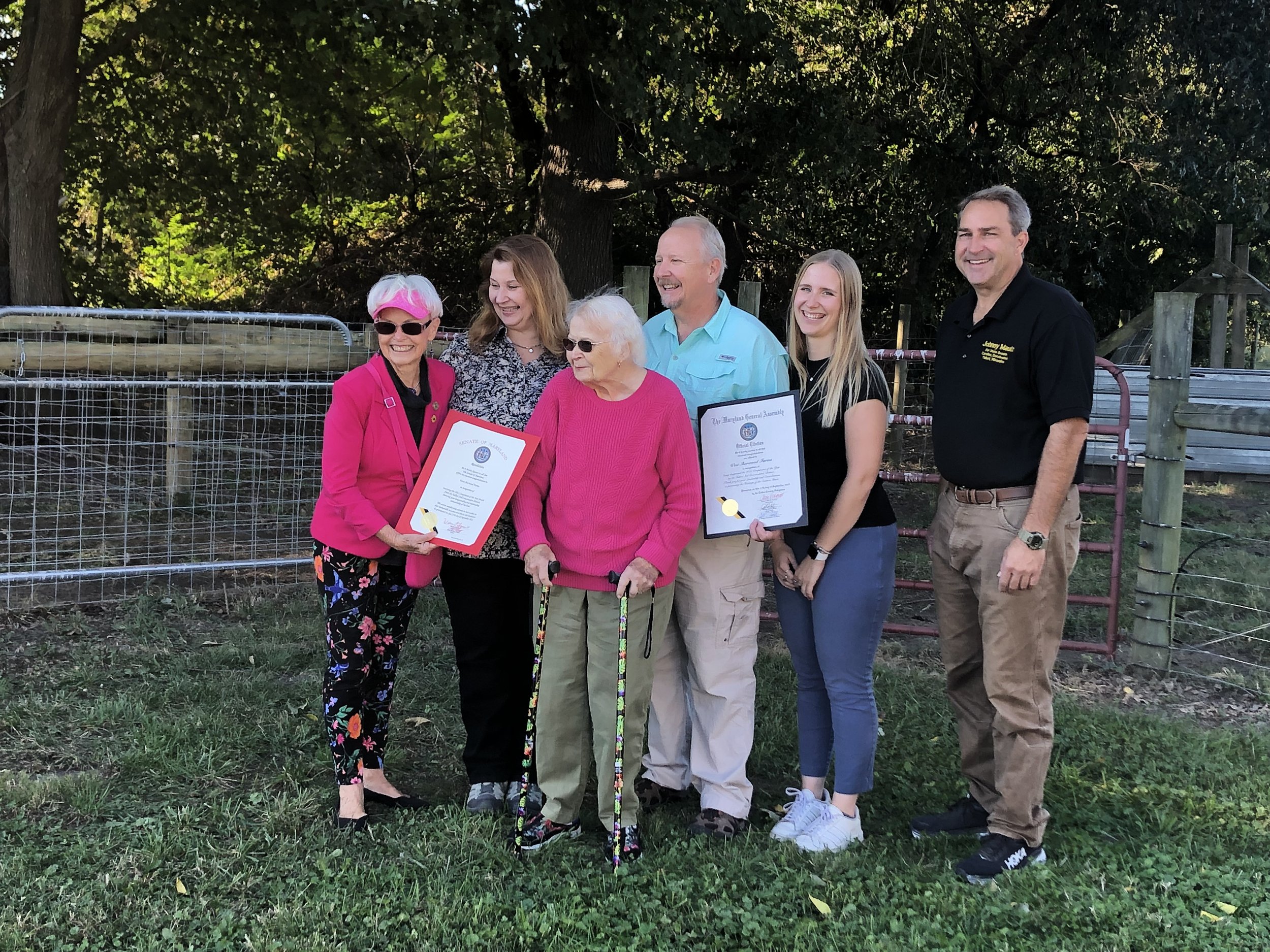
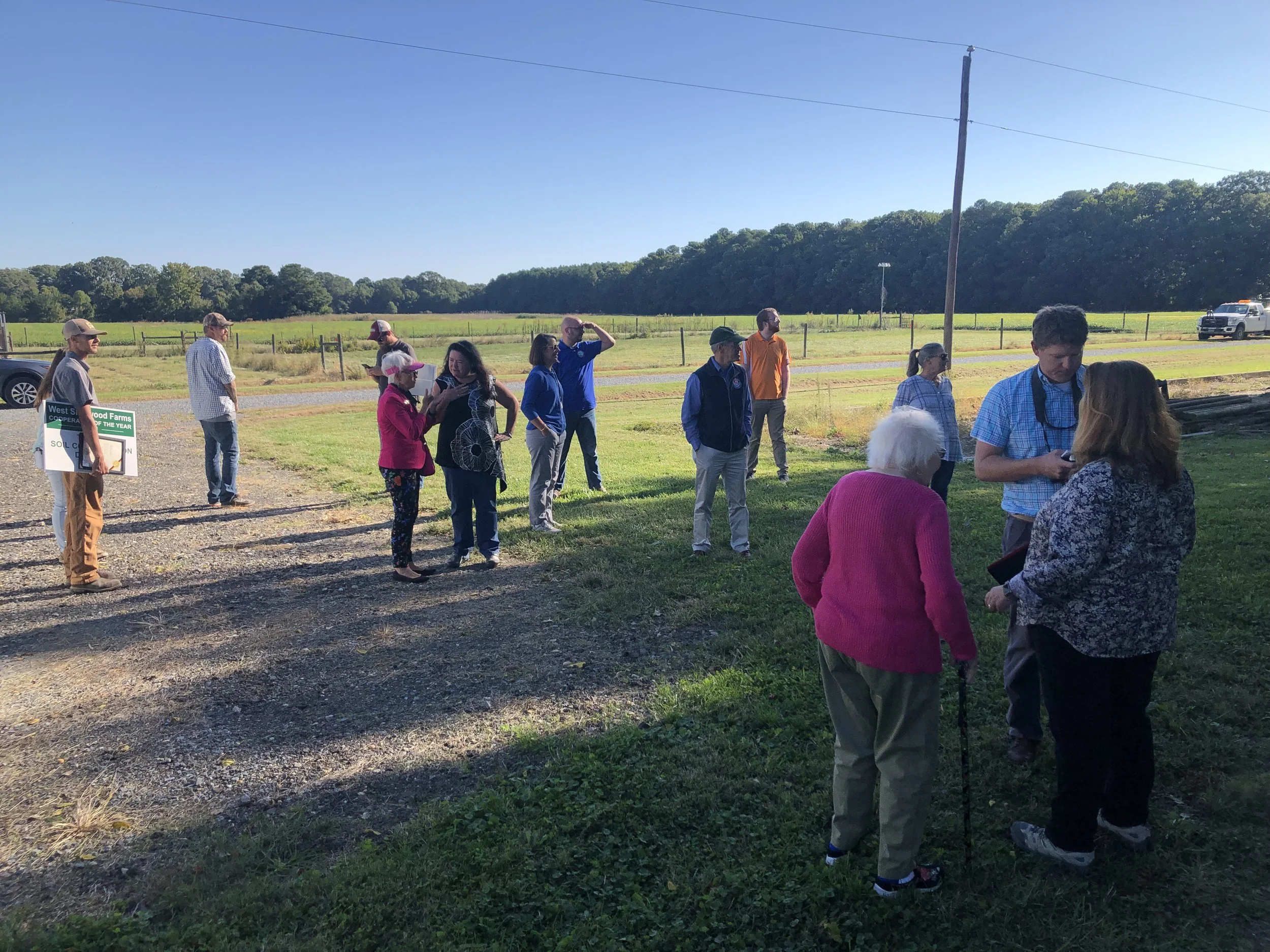
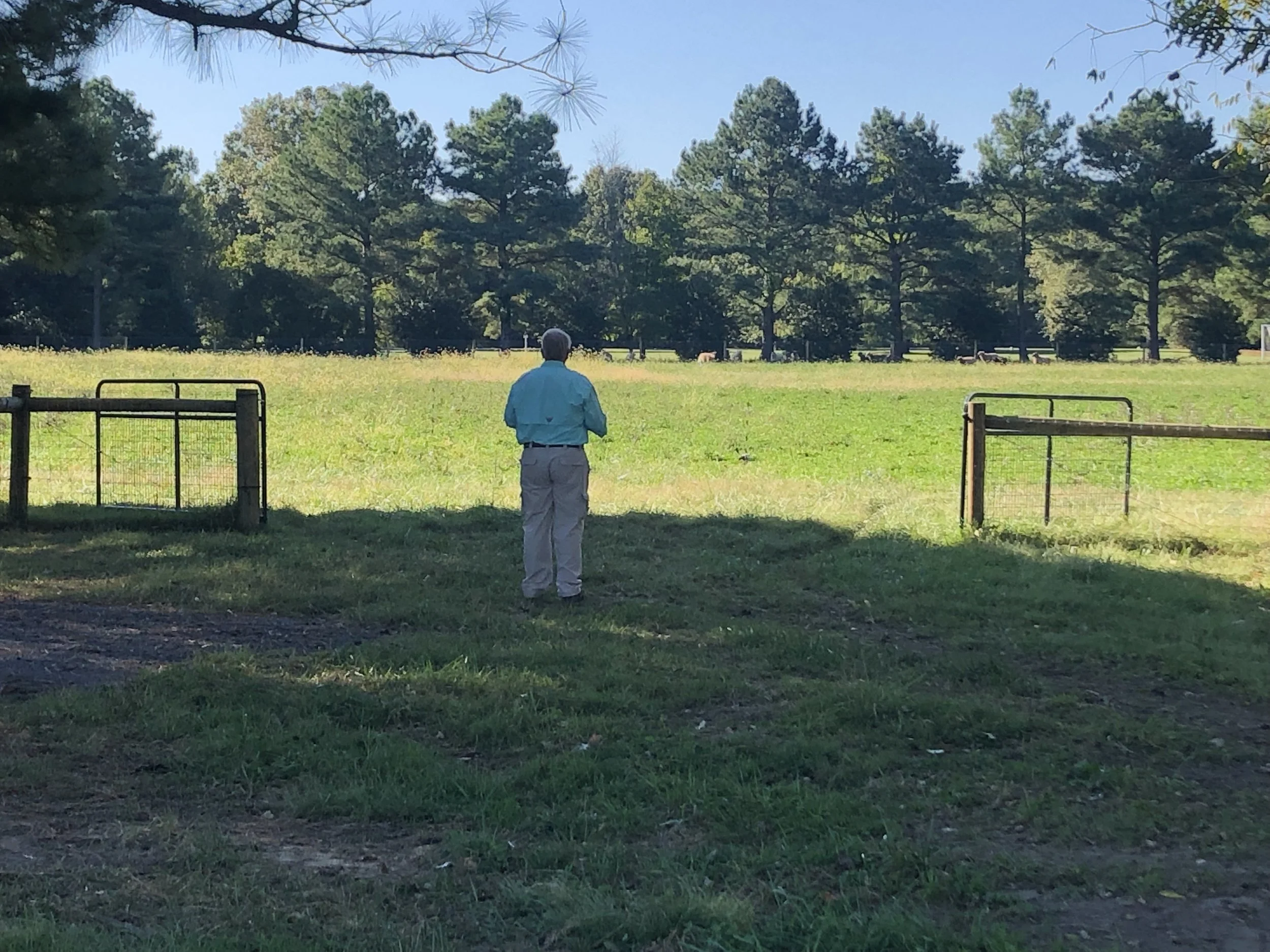
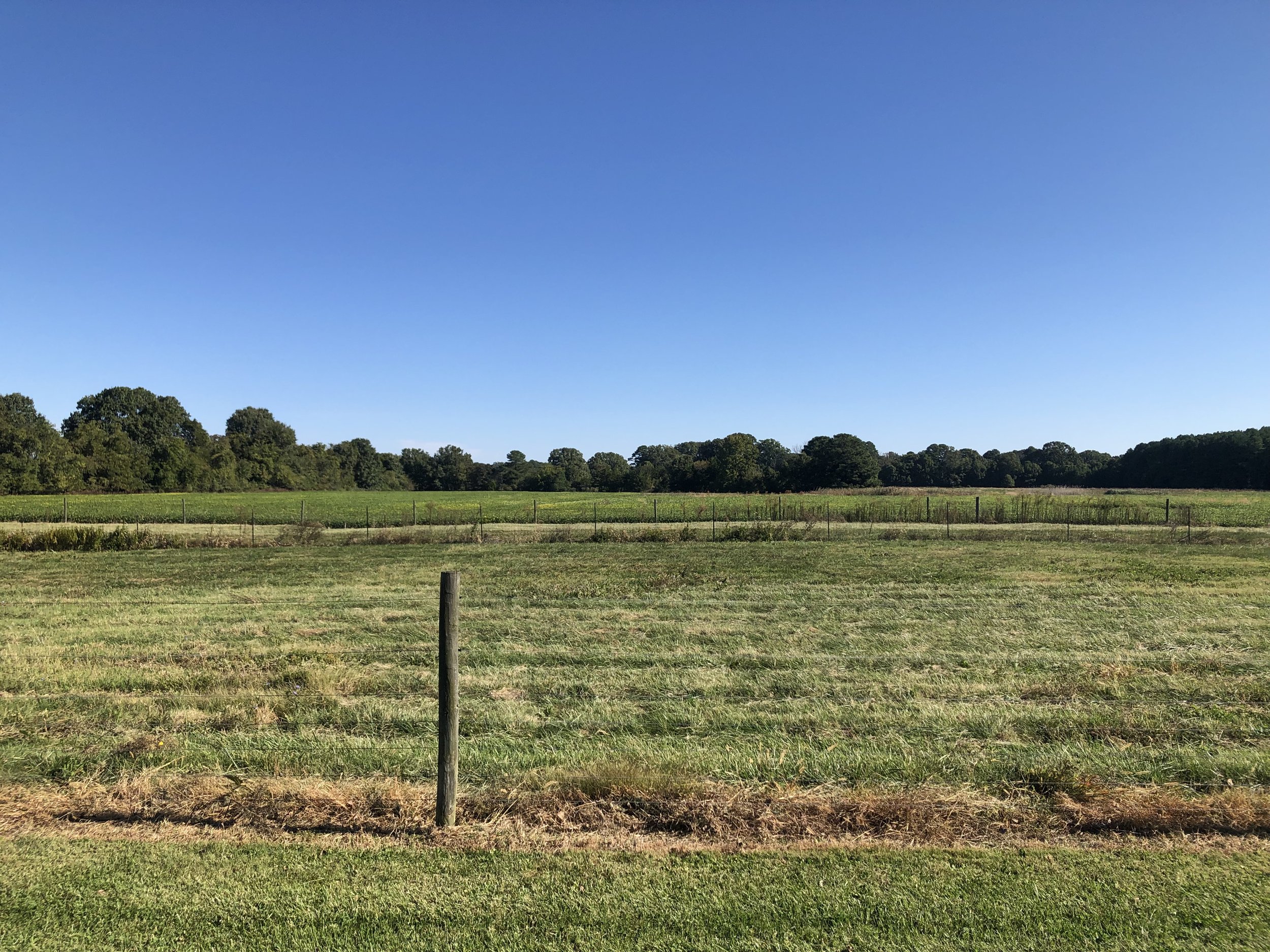

The Talbot SCD is pleased to recognize the 2021 Cooperator of the Year Award to the Burns family of West Sherwood Farms. Ernest (Ernie) Burns of West Sherwood Farms in St. Michael’s Maryland has been a longstanding and outstanding cooperator with the Talbot Soil Conservation District for many years. West Sherwood Farms raises sheep on 7 acres of pasture, and also manages over 40 acres of cropland.
Ernie has worked with us on a number of projects, including wetland restoration, pasture improvements in 2010, and most recently a pasture expansion project which is ongoing. Ernie is a wonderful steward of the land, and is a joy to work with. Ernie is also an Agricultural teacher, which allows him to spread his knowledge to the next generation.
The Talbot Board of Supervisors and field staff congratulate West Sherwood Farms on being named the 2021 Cooperator of the Year!
|
Photo (left to right): Ben Beaven, Mark Beaven, and Andy Beaven.
The Talbot Soil Conservation District is pleased to present the 2020 Cooperator of the Year award to both the Beaven and Shortall Family for their recent conservation work on their farms outside of Easton. In 2019, the two families were able to work together on addressed a severe erosion problem by restoring a large wetland which acts as a sediment trap as well as a natural filter for other agricultural nutrients.
The Shortall family, which consists of Henry and Shirley Shortall and their son Mickey, operate a 211.3 acre cash grain farm outside of Easton. In the fall of 2019, after waiting patiently for assistance, they were able to establish a grassed waterway with a lined outlet which addressed massive amounts of soil erosion from leaving the farm. They also have other land enrolled as grassed buffers through the Conservation Reserve Program.
Brothers Mark and Andy Beaven recently acquired their family farm when their father, William “Bill” Beaven, passed away in 2019. The farm is located just outside of Easton along the Kingston corridor. In the fall of 2019, they were able to restore a wetland and installed grassed waterways which addressed massive amounts of soil erosion from leaving the farm. They enrolled the land into the Conservation Reserve Program. Their father was a pioneer in the no-till field who worked for many years for the Soil Conservation Service, and also served as a member on the Talbot SCD Board of Supervisors.
The Talbot SCD Board of Supervisors were finally able to present the award on Wednesday, October 20, 2021.
|
The Talbot Soil Conservation District is pleased to recognize Mr. Samuel R. Leonard Jr of Friendship Farm located on Deep Neck Road outside of St. Michaels as our 2019 Cooperator of the Year for his commitment to agriculture and to conserving and protecting the natural resources of Talbot County.
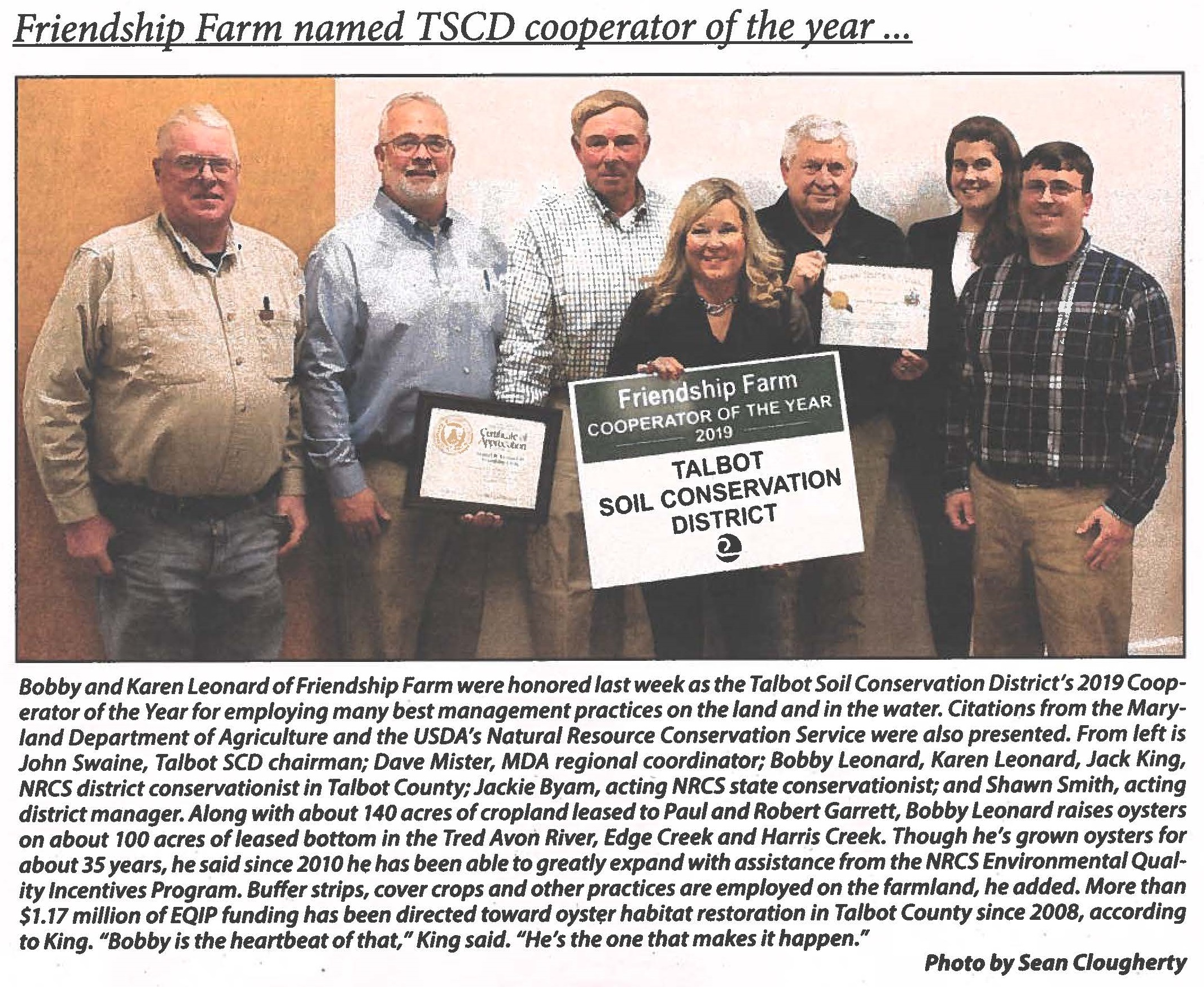
|
George Brennan with Craig Zinter, former Talbot SCD Manager
The Talbot Soil Conservation District is pleased to recognize Mr. George Brennan of Tamsey Farms located on Fox Road outside of Easton as our 2018 Cooperator of the Year for his commitment to agriculture and to conserving and protecting the natural resources of Talbot County.
Mr. Brennan started farming full time after a 20 year career in the United States Marine Corp where he achieved the rank of Lieutenant Colonel. While serving in the military Mr. Brennan and his wife Mary purchased their first farm in Talbot County in 1973. With no prior farming experience and after extensive research, they decided to raise polled Herefords. Soon after, a bull and two heifers were purchased thus beginning a new and exciting chapter in their lives.
In 1977 he purchased the adjoining 335 acre farm which provided more pastureland to allow for an expansion of the herd. Following the purchase Mr. Brennan started installing conservation practices on his own and with the help of the Talbot Soil Conservation District. Over the years, these measures included numerous waterways, rock outlets, tile wells and grassed buffers. The grassed buffers range from 20 to 25 ft. in width and were installed around all pasture fields in sensitive erosive areas.
While maintaining and growing the herd, Mr. Brennan was offered to purchase Elliott Hardware & Equipment, the local International tractor dealership. Mr. Brennan assumed ownership in 1981 and jokingly referred to the purchase as a “bad decision”. The name has since been changed to “Rio Del Mar Enterprises” to evoke memories of a beach in California with the same name where the Brennan’s enjoyed spending their time. “Rio Del Mar” means “River by the Sea” and, contrary to misconceptions, does not have anything to do with the location being near the Delaware Maryland line. The business continues to serve farmers and landowners with various landscape equipment.
In order to accommodate an ever increasing herd size, Mr. Brennan purchased Eaton farm in the early 90’s. At the peak of production there were around 200 total animals over the 3 farms. And, as a MACS cover crop participant, Mr. Brennan was allowed to cut his cover crop grain for feed, rather than to destroy. After more than 40 years of working with the polled Herefords, and with no immediate family in the area to take up the task, Mr. Brennan took his stock to an Illinois auction in early 2016. Over the years he had few dangerous situations, mainly due to the Herefords temperament. Mr. Brennan stated “he misses the cows, but not the work”. The pasture land has since been converted to crop land and is tilled by the Garrett Brothers.
Our most recent project with the Mr. Brennan was the creation of a 6.6 ac wetland restoration through the CREP program. This was an area that had always troubled Mr. Brennan as it was wet and could only be cropped successfully 1 out of 8 years. Including berms and buffers the area protects environmentally sensitive land which has been taken out of production to provide enhanced wildlife habitat.
Although the farm has changed over the years, from cropland to pasture fields and hayland and then back to cropland, Mr. Brennan's commitment to stewardship has not wavered. The wire fencing will stay in place in order to prevent narrowing of the grassed buffers for years to come.
The Talbot Soil Conservation field staff and board of supervisors would like congratulate Mr. George Brennan of Tamsey Farms as our 2018 Cooperator of the Year. Congratulations!
|
Larry Ewing with Craig Zinter, former Talbot SCD Manager
The Talbot Soil Conservation District is pleased to recognize the Ewing Family of Easton as our 2016 Cooperator of the Year for their commitment to agriculture and to conserving and protecting the natural resources of Talbot County. The Ewing Family consists of Larry, Margaret and their sons, Brian and Stephen who farm 1100 acres along Matthewstown Road. The Ewing family can be found in Maryland as early as 1718 and have a long history as farmers.
Larry’s parents, Lawrence from the Churchill area of Queen Ann’s County and Muriel who was a “town” girl from Easton, were married in 1946 and farmed in Queen Anne County until they rented their farm in Talbot in 1949 later purchasing it in 1952. Over the years several more farms were purchased along Rt. 328 with tillable acres now reaching 1100 acres. When Larry was young the farm was a dairy with about 80 head. Larry much preferred tractors to cows and drove his first tractor raking straw at the age of 5 before he was even able to reach the pedals. Lawrence started the tractor heading down the field in low gear and told Larry to turn the switch off when he reached the other end. Once Lawrence caught up to him with the baler he restarted Larry’s tractor, turned him around, and sent him back in the other direction. Larry never understood why the others kids called it summer vacation as in Larry’s words his dad worked the “snot out of him” over the summer. Larry said his dad always stressed hard work while his mom stressed education. Because of this he earned a business degree from Brandywine College, now Widener University near Wilmington, DE. In 1974 Larry was 21 and returned to the farm. He met Margaret in January of 1975 in a pool hall as Larry tells it which was actually a friend’s garage with a pool table. Margaret was a farm girl who was born in Texas but moved to Maryland at age 11 when her father came here to manage the Two Rivers Dairy Farm in Caroline County. By March 1975 Larry and Margaret were engaged and in June of the same year they were married in the front yard of his parent’s home as the pea pickers harvested the Ewing’s pea crop across the road.
A shallow water area installed on Ewing home farm, just outside of Easton.
Today the Ewing’s are 100% no-till for the soil conservation, time and fuel saving benefits. Larry has a few vivid memories before they went to no-till. For the first 7 years of their marriage Larry and Margaret lived in the old farm house on the Ewing’s Caroline County farm just across the Tuckahoe from Talbot. As Larry described it the wind and snow blew freely through that house. Larry was working ground one day when the wind was blowing the dust so much he couldn’t see the house. He came in that evening and went to wipe the dust from the window only to realize that it was on the inside. Margaret had covered all the furniture with sheets to keep the dust off. Over a few days, topsoil had drifted 20 feet into their yard, wind erosion at its prime. At a time when fields were tilled from the edge of trees to the fence line, it was obvious as signs or erosion appeared, that it was more crucial to take measures to keep it where it belonged. The Ewing’s, upon their own initiative, left out buffers and established waterways in those chosen areas that were at risk of erosion. The 1970’s were good years on the Ewing Farm, but in contrast the 1980’s were tough and things were done to minimize costs. One of these things was to rent a no-till planter to plant double crop beans after wheat. In 1982 the Ewing’s bought their first Allis Chalmers no-till planter set up to fifteen 15” rows. This planter was used to plant all of their beans no-till as well as to do custom no-till planting for other farmers. About the same time, Rueben Swann approached them about planting 20 acres of no-till corn, just to try as an experiment. At harvest the no-till corn was 20 bu. /acre better than the conventional corn. By then Lawrence’s old John Deere 894 planter was about worn out so they added liquid fertilizer to the AC planter and converted to eight 30” rows so they could no-till all their corn. Wheat was the last crop that was planted with conventional tillage until Larry started participating in the cover crop program in 2006 and purchased a Great Plains no-till drill. Today the Ewing’s use a GPS controlled 12 row Kinze planter pulled by a Case IH tractor with RTK guidance. The Ewing’s were early adopters of yield monitors going back to the early 1990’s. Larry uses this information and his business school training to keep track of all costs and profits per acre.
The rich silt loam soils of the Ewing farms are productive but also erodible. The Ewing’s seeded many of the natural drainage ways to permanent grass which along with no-till has stabilized these areas. The Talbot Soil Conservation District was asked to assist with a particularly troublesome area just south of Rt. 328. A culvert under the road collected and concentrated the runoff from the fields north of the highway. The water flowed across the fields south of the highway toward the branch taking much of the topsoil with it. The District, with MACS funding, installed a project with 1.5 acres of grassed waterway two grade stabilization structures, and 60 feet or rock lined outlet in the fall of 2010 to stabilize this area. Our most recent project with the Ewing’s was the creation of a 0.4 ac wetland restoration and a 0.8 ac shallow water wildlife area through the CREP program. This was an area that had always troubled Larry as it had several springs and was wet could only be cropped successfully 1 out of 10 years. Including berms and buffers the area encompasses 2.4 acres of environmentally sensitive land which has been taken out of production to provide enhanced wildlife habitat. Larry and his family are so pleased with this project he’s already planning the next one for another troublesome area.
Over the years the Ewing’s have been active with many organizations including Farm Bureau, Fellowship of Christian Farmers, Gideon’s International, Ruritan, The Talbot Chamber of Commerce, and they had been Sunday school teachers for many years. Larry said his experience serving on the board of the Talbot County Farm Bureau was most rewarding in regards to being enlightened as to all that Farm Bureau does on behalf of the Ag community. In recent years the Ewing’s have pulled back from many of these activities as Larry puts it “we are looking after mom and dad as they are well into their 90’s and there is much to learn about that.” Lawrence and Muriel just celebrated 71 years of marriage! If there is one thing the Ewing’s are known for in Talbot County it’s their airplane and the airstrip on the farm next to his parent’s house. Larry, his Dad, and Mom all got their pilots licenses after taking flying lessons at the Easton airport in 1972. For years they were members of the International Flying Farmers and have flown as far away as Canada and Central America with groups of up to 12 planes. For many years the elder Ewing’s spent their winters at their home in Naples, Florida which was just a short 6 hour flight away. Larry still remembers back to 9/11 when the FFA called and told them that nothing leaves the airstrip or they would be shot down. Since that time flying has become over regulated, like many other activities.
Larry’s farming philosophy is summed up as “We’re fortunate to have good ground, we try to do a good job and above all, try not to forget the blessings of family and to make time to enjoy them.” He’d like the see the farms stay in the family and as good productive Talbot County farmland. When asked what’s next for the Ewing farms, Larry said irrigation, but perhaps that’s up to the next generation. Larry and Margaret have begun to take time to travel, visiting 9 European Countries thus so far, and there are many more places on their list. While the Ewing’s have been farmers for as long as anyone can remember it seems very likely the trend will continue for several more generations.
|
The Brinsfield's with Craig Zinter, District Manager and Dr. Terron Hillsman, NRCS State Conservationist.
The Talbot Soil Conservation District is pleased to recognize the Brinsfield Family Farm of Cordova as our 2016 Cooperator of the year for their commitment to Talbot County Agriculture, to the dairy industry, and to conserving and protecting the natural resources of Talbot County. The Brinsfield Family Farm is a 150 acre, 150 cow dairy farm owned and operated by William M. Mac Brinsfield, Jr., William M. Billy Brinsfield, III and Susan Brinsfield. Billy and his wife Carol, who works at the Benedictine School, have two children at home Tyler who is 12 and Clara who is 7 and a daughter Rachel who is 21. The farm originally known as the Saulsbury Farm was first rented by Mac’s father in 1942 and later purchased in the early 1950’s. Mac’s grandfather farmed off Covey’s Landing Road on what is now one of the Allen Harim farms but the family left that farm when he died at age 47. William Brinsfield, Sr. started with Guernsey cattle but switched to the Holstein breed in the early 1950’s. About the same time he was one of the first in the county to adopt artificial breeding. The Brinsfields focused their breeding program on milk production and butterfat content and then switched their focus to protein production in the 1990’s in response to market demands. Billy is proud to say that there hasn’t been a bull on the farm for 70 years and that there have only been 3 cows purchased in the last 50 years. Today the Brinsfields have a closed herd with no cattle being brought in and surplus heifers sold to other dairy farms.
William, Sr. milked 25 cows until his retirement in 1974. Mac operated the farm through the 80’s with 40-50 head. When Billy graduated from UMES in 1992 with an Animal Science degree there were 65 milk cows on the farm. Billy had thoughts of becoming a vet until his mother Bonnie died in 1989 after which he decided to finish his degree and return to the farm to help Mac. Talbot County experienced a major drought in 2002 which challenged the Brinsfields to produce enough feed for their cows. They were able to survive by chopping their neighbor’s corn fields which did not produce any ears. While the soils in their neighborhood are sandier than many in Talbot County they are fortunate to sit above the abundant Federalsburg aquifer which runs in a narrow band just north of Cordova to just north of the Brinsfield Farm. Irrigation was added in 2005 which insured a steady supply of feed for the cows and allowed the herd to expand to 150 cows where it is today. The Brinsfields produce most of their forage on the farm but buy their grain and dry hay. Sweet corn caps purchased from the nearby Friel Cannery are also used for silage. Billy says that 150 cows is probably their maximum size and that the greatest limitation today is labor and manure utilization. It takes the three Brinsfield family members plus a full time hired man, a part time milker, and two high school workers in the summer to get all the work done. While dairy farming is labor intensive it is impressive that 150 acres and 150 cows can support so many people.
Happy cows
The first manure storage structure was completed in 1990 and was a 40’ x 50’ x 4’ deep concrete lined pit designed to hold 30 days of manure from 60 cows. Interestingly, it was located on the highest point of the barn yard to minimize the amount of runoff entering the tank. As the cow herd grew and manure handling standards changed this structure became inadequate. Current standards require the waste system to contain the runoff from a 25 year storm which is 6” of rainfall in a 24 hr period. In 2006 a comprehensive nutrient management plan was commissioned through the Environmental Quality Incentive Program and prepared by Conestoga Rovers and Associates, a Michigan based consulting company with extensive dairy experience throughout the northeast. The Brinsfield Farm presented some challenges in that it is relatively flat and has a seasonal high water table. A traditional gravity based system of transferring manure to an in ground concrete tank would not work here. To complicate things even more the Brinsfields use sand for bedding because it is inert and doesn’t support bacteria like shavings or straw. Sand settles out in manure storage and is difficult to re-suspend. The solution was determined to be a concrete sand settlement alley and an above ground steel circular tank.
Sand separator alley
The application and design process began in January 2013 with construction beginning May of 2014 and being completed in August of 2015. The manure is pushed into one end of the 172’ long x 25’ wide x 5’ deep concrete alley. As the manure flows via gravity to the far end most of the sand settles out and the lighter manure solids and liquid are pumped into the above ground steel tank. The sand separation alley has a ramp to allow a skid loader to enter and scoop out the settled sand. The tank is 101’ diameter by 19’ high, holds 1,080,000 gallons, and was built by F.S.R.C. Tanks from Bolivar, Ohio. While a concrete tank would have been less expensive the steel tank allows the removal of a couple of wall panels to scoop out accumulated sand every 5-10 years. A third part of the waste management system is a 40’ x 64’ solid stacking structure built by Eli Miller with Keystone precast concrete walls. The sand and solids scooped out of the sand separation alley as well as the bedding pack manure form the calves and heifers are stored in this building. The building is also sized to allow room for composting of animal mortality. All of these practices are connected with various pipelines, pumps, and concrete heavy use areas, to contain and transport the manure and contaminated runoff. There is also a roof runoff structure which is government speak for a stone lined trench and pipeline which conveys the clean runoff from the free stall barn away from the waste storage system preventing it from becoming contaminated and needlessly adding extra water to the manure. Other key contractors who worked to bring this project together included Knipple Inc. who did all the excavation, Eastern Shore Concrete Construction who poured the concrete, and Cedar Crest Equipment who supplied and installed the pumps. This extensive system required the combined resources of the Maryland Agricultural Cost Share Program which cost shared the tank and the Natural Resource Conservation Services Chesapeake Bay Watershed Initiative which cost shared all other practices.
The Brinsfields have also been long time participants in the MACS cover crop program which works well for them in that they can grow rye for cover crop and then harvest it for forage for their cows. They also anticipate participating in the MACS manure transport program to transfer excess manure they can’t utilize to some of the neighboring farms who can.
While no one can predict the future, if the past is any indication, the future looks bright for the Brinsfield Family Farm. The second and third generations have taken steps to insure that the farm can continue as a successful and environmentally responsible dairy farm for years to come. Already, Billy’s 12 year old son Tyler is expressing an interest in becoming a vet and perhaps a dairy farmer like his father, grandfather, and great grandfather before him.
|
Billy & Jenny Shortall
The Talbot Soil Conservation District is pleased to recognize Billy and Jenny Shortall as our 2011 Cooperator of the Year. The Shortall's live on their 400 acre Discovery Farm located in Trappe. Billy rents 11 other farms within a 6 mile radius, all totaling 1700 tillable acres, which are used for cash grain production. Most of the farms are share cropped with the landlords receiving a share of the crop and paying a share of the expenses. This arrangement requires a level of trust and cooperation not found in the more common cash rent agreements.
Billy first started farming with his Aunt and Uncle Ethel and William Bryan after finishing high school in 1979. He worked side by side with his uncle until Mr. Bryan's passing in 1992. Billy is still farming several of the farms that his uncle once tilled. All the work is done with the help of a full time employee Steve Shores, part-time help from his father Mike, and occasional help from his brother Mickey, a real estate appraiser in Easton. The Shortall's have one son, Bill, who is lives in California.
Billy and Jenny, who were married in 1982, have lived on the farm, first in a trailer, later in a rancher they built on the corner of the farm, and currently in the farm house the Bryans once lived in. The farmhouse was totally remodeled in 2002 and now reflects Jenny's sense of style.
Billy has worked with his landlords to recognize and repair any erosion problems. There are numerous waterways and drop structures safely conveying runoff from the fields to the streams. Billy has enrolled 185 acres in the Conservation Reserve Enhancement Program on land which is better suited to conservation than crop production. Just recently Billy was recognized by the Farm Service Agency for exemplary participation and promotion of the CREP program. Billy regularly participates in the annual Cover Crop Program and is currently enrolled in the Conservation Security Program. The cropland is farmed using no-till practices to further protect the soil and the environment. A Turbo Till is used ahead of corn planting to minimize slug damage and in the fall when seeding cover crops. In the spring, Billy seeds approximately 75 acres of corn and millet in numerous shallow water wildlife ponds as many of the rented farms are managed for waterfowl hunting.
Jenny is equally busy with her new salon "Beautiful Discovery" on Aurora Street in Easton which opened on 1-1-11 after 4 hectic weeks of remodeling. Now that things are up and running she spends 20 hours per week in the salon managing her staff of 9. When not running the salon, she keeps the farm's books, which is no small task since the income and expenses must be kept separate for each farm so it can be shared with the landlords under the share crop arrangement.
The Shortall's lives changed in February 2010 when Billy had heart bypass surgery. All winter, Billy was short of breath but put off a visit to the doctor until after hunting season. When he did see the doctor, Billy was scheduled for immediate surgery. By March, Billy was well enough to go on their annual two week vacation to their timeshare in St. Martin and by planting season Billy was back to 100%. In August 2010 the Shortalls purchased a condo in West Ocean City where they spend as many weekends as possible, boating, laying on the beach or by the pool, shopping, and just relaxing.
Heart surgery made Billy and Jenny realize that there is more to life than working all of the time. While work is important they've made steps to simplify their lives and to take time to rest and enjoy time together. The Shortall's goal is to work hard and be successful until retirement. Regardless of who tills Discovery farm in the future it will always be a farm having been permanently preserved in the Maryland Agricultural Land Preservation Program.
Again our congratulations to the Shortall's for being selected as our 2011 Talbot Soil Conservation District Cooperators of the Year.
|
The Talbot Soil Conservation District is pleased to recognize Chip and JoAnn Councell of Councell Farms as our 2010 Cooperator of the year. Chip and JoAnn along with their son Jason operate Councell Farms, a retail produce market along Route 50 at Skipton, as well as a grain farming operation in the Cordova area.
The Councell Family began farming in Talbot County around 1690 with Chip being the 10th and Jason the 11th generation of Councell farmers. Chip's grandfather was born on the Dolvin Farm near Wye Mills. He purchased the Whitemarsh Farm, where Jason and his family now live, in 1952 . Chip's father Phil, grew up on the Whitehouse Farm at Presquile and had a dairy herd. Chip grew up on the Slaughter Farm located at the south end of Church Lane. After the dairy, the Councell family raised hogs until the early 1970's and were primarily grain farmers until their first crop of vegetables in 1981. Interestingly enough, Chip acquired the remainder of the Dolvin Farm 99 years after his grandfather lived there through a transfer of development rights for the Preserve housing development. The current Councell men marvel at the fact that Chip's Grandfather tilled over 400 acres with horses and mules.
Chip and JoAnn were married in May of 1981 and started Rainbow Farms that summer. The name was chosen because they hoped to find their pot of gold at the end of the rainbow. JoAnn says the "Pot of Gold" has turned out to be all the friendships they have developed with their customers and employees. The name of the produce market was changed to Councell Farms to better reflect that it was a family operation when Jason joined in 2004. Today Jason is in charge of vegetable production and entertainment farming. JoAnn runs the market and Chip handles the grain operation. Responsibilities may sound well defined on paper but everyone pitches in to do whatever needs to be done at the time. The Councell's daughter, Melissa is a teacher at Ridgely Elementary School and works for the board of education during the summer. When the need arises Melissa is often recruited to help out. Chip's father, Phil still helps everyday and JoAnn's mother, Flossie and sister in law, Betsy also help at the market. The newest Councell is Jason and Casey's daughter, Avery, born on July 1, 2010. Casey is the former Casey Morris of Cordova and works as a paralegal with Miles and Stockbridge. During the fall Casey can be found at Councell Farms on the weekends helping with the ag entertainment activities.
Of the numerous produce markets in Talbot County, Councell Farms is the most prominent with the red barn, giant watermelon, basket of tomatoes, and John Deere combine slide. Chip bought the old combine at an auction and enlisted an engineer buddy to design the slide. The engineer precisely measured the combine and produced CAD drawings. The slide was specially made in California and when all the parts arrived at Councell Farms everything fit together perfectly.
The market opens in the summer when the first local sweet corn is ready; usually coming from the sandy soils around Preston, for the first week, followed by Councell's own a week later. About 85% of the produce sold, including: corn, watermelons, cantaloupes, and squash are grown by the Councells. Other crops such as string beans and peaches are purchased from local farmers. All of the fall crops are grown on the farm with the exception of apples and cider. During the summer about 60% of their customers are local with local patronage rising to 80% during the fall. The market is open daily from 8 am - 6 pm. Around Labor Day, Councell Farms closes for 2 weeks while they transition from summer to fall crops. The fall activities run through the end of October.
In 2008 the Councell's expanded into Ag Entertainment and now JoAnn conducts tours for 2500 school children each September and October. The children get to participate in 22 different farm related activities and the Councells make it a point to add a new activity every year. Activities are targeted to families with small children rather than teenagers. In the fall the big attraction is the pick your own pumpkin patch .
The farm land which is not needed for vegetable production is used for grain production with a crop rotation of corn, full season soybeans, wheat, double crop soybeans, and then back to corn. Chip wanted a vertical tillage implement but didn't think he could justify the cost of a new one so he built his own. He started with a used John Deere disk frame, straightened the gangs out, and added new wavy coulters. He then bought a used field cultivator with a rolling basket, removed the basket and put it on the disk frame, and resold the field cultivator. When completed, Chip's machine cost less than 10% of what a new implement would have cost. Chip's vertical tillage implement is used to incorporate poultry manure in the spring prior to planting corn and in the fall on bean stubble before planting wheat. Most corn acreage receives an application of poultry litter which is purchased from a local farmer and spread with a GPS equipped Terragator.
While the busy summer schedule at the market keeps them from being actively involved in many of the local service organizations the Councells do try to support these organizations. Chip and JoAnn regularly donate produce to several organizations, such as the Talbot County Farm Bureau, Talbot Waterman's Association, Easton Ruritan Club, and local fire departments and churches.
What's next for Chip and JoAnn and Councell Farms? Their short term goal is to use the market not only as a profitable business but also a venue to educate the public about agriculture. This year, with assistance from Maryland Grain Producers, educational signs will be added to the market and tour areas. Over the longer term Chip and Jo Ann want to be able to transition Councell Farms to the next generation, with the same opportunities given to them, and to make room for any family member who wants to become involved in the operation. Together, they see lots of opportunities in agriculture and are excited to be a part of it. Again, our Congratulations to the Councells for being selected as the 2010 Talbot Soil Conservation District Cooperators of the Year.
|
The Talbot Soil Conservation District is pleased to recognize Mark and Vicki Sump, owners of Dunmore Heath Farm as the 2009 Cooperators of the Year. Dunmore Heath Farm came into the family when Vicki's great grandfather purchased it 104 years ago. Vicki's grandfather, Kenneth Dulin owned the farm for 50-60 years before Mark and Vicki purchased it in 1987. At 89, Mr. Dulin still lives on the farm in the house next door to the Sumps. Dunmore Heath Farm is a Century Farm recognized by the Maryland Department of Agriculture for being owned by the same family for 100 years and it is forever preserved through the Maryland Agricultural Land Preservation Program.
Mark and Vicki both local to the Cordova / Queen Anne area were married in 1980. They have two daughters; Sherri, 28 who is married to Danny Brown and lives in Cordova with their children Dalton and Olivia, and Courtney, recently married to G.R. Cannon who lives in Royal Oak. Sherri works at William Hill Manor as a Move In Director and Courtney is a massage therapist working at Your Docs In.
Dunmore Heath Farm has been a poultry farm since 1962 shortly after the Bayshore Foods Company came to the area. Mr. Dulin raised chickens until 1985. Mark and Vicki upgraded the two original poultry houses in 1987 when they bought the farm and have been Allen's growers ever since. Perhaps the most notable event at the farm was the tornado which went through on May 18, 1995. The tornado destroyed every thing but the poultry mortality composter build by the Beechy Construction Company. Lost were; the 6 year old ranch home Mark and Vicki built, two large barns, and the two original poultry houses. Mr. Dulin was more fortunate and only lost his attached garage.
The Sumps rebuilt a nice cape-cod style house and a new shop. Plans already in the works for two new chicken houses turned into plans for three new 42 x 548 houses. Today, on one of the tidiest poultry farms in Talbot County, the Sumps raise 6-7 flocks per year of Allen's small birds which average 4.6 pounds in as little as 37 days. These birds are processed just around the corner in Allen's Cordova plant. According to Mark the best part of the poultry business is the chicken check and the worst part is the paperwork. Another prominent farm enterprise is the 3/4 acre of green houses which were built in 2004. These are used to produce annuals under contract with Bell Nurseries of Burtonsville, MD which supplies plants to Home Depot. The green houses can hold 18,000 flats and 5000 hanging baskets and produce two turns of plants from January through July 1. Normally, one person can water and fertilize the plants but the two weeks of the season when plants are brought in or loaded out requires 5 to 7 people. Despite the recession, Vicki said annual plant sales have held up and 2009 was their best year yet. Aside from the poultry and greenhouse operations the farm is also a grain farm which includes the home farm on Kitty's Corner Road, a farm on Lewistown Road purchased in 2007, and 10 rented farms in Talbot and Caroline Counties. Major crops include corn, soybeans, wheat, and in previous years barley.
Dunmore Heath Farm has a long history of conservation. Mr. Dulin completed a number of drainage projects and installed two ponds in the early 1970's. Mark has continued the conservation work through the Conservation Reserve Enhancement Program, the Environmental Quality Incentive program, the Maryland Agricultural Cost Share Program, the Conservation Security Program, and most recently has sold carbon credits through a mid western aggregator.
A wet area of sensitive soils around the two ponds was planted to permanent vegetative cover through the Conservation Reserve Program in 2000 (31 - CRP Field). This protects the ponds from sediments and runoff and provides wildlife habitat.
The Maryland Agricultural Cost Share Program or MACS has assisted with the construction of two manure buildings and two composters on the Sump farm. The first manure building completed in early 1994 was destroyed in the tornado a year later. A replacement manure building was completed in 1996 along with a larger composter to handle the increased poultry production.
The Sumps have done several projects through the Environmental Quality Incentive Program or EQIP for short. In spring of 2006 the mark and Vicki had a Comprehensive Nutrient Management Plan prepared with EQIP assistance. This plan addresses all aspects of the poultry operation including: manure handling, nutrient management, feed management, and conservation practices. In fall of 2006 concrete Heavy Use Pads were installed at the far end of each chicken house. This provides a stable surface which is easily cleaned where the manure is removed from the houses. In 2008 Mark and Vicki replaced a travelling gun irrigation system with 50% efficiency with two center pivots with efficiencies of 97%. Also as part of their EQIP contract they had an Irrigation Water Management Plan developed which they will follow to fine tune their water use efficiency. An upcoming EQIP practice is the use of litter amendments to reduce the amount of ammonia which is lost and to increase the amount of nitrogen in the manure.
In 2006 the Conservation Security Program came to the Choptank and Nanticoke watersheds and Mark and Vicki signed up for 10 years. This comprehensive program addressed a wide range of management issues including: Energy, Soil, Water, Nutrients, Pests, Air Resources, and Habitat. Some specific items the Sumps chose to do for CSP were: 5 & 10ft buffers along ditches, recycling used motor oil, using manure to supply crop nutrients, using biodiesel, continuous no-till, and including legumes in crop rotations The CSP practice with the most immediate returns was the Energy Audit conducted by a trained expert who reviewed the farm and made recommendations to save energy. As a result of the audit new more efficient tunnel fans and fluorescent lights were installed in the poultry houses. The fans worked well but Mark found the chickens didn't grow as well with the fluorescent lights and has switched back to incandescent. New fans were also recommended for the greenhouses but the Sumps couldn't justify replacing 4 year old fans just yet. Mark is so adamant about the benefits of no-till that he has sold his plow for scrap and purchased a Phoenix harrow. The Phoenix harrow has tines which just scratch the soil surface and disturb the residue enough to mix poultry litter into the soil, to prepare a seedbed for cover crops, or to dry out wet ground. The harrow covers 42 ft, can be pulled fast, and requires relatively little horsepower so it is a quick and efficient tool. One side benefit is that the continuous no-till allowed the Sump's to sell carbon credits through the Chicago Climate Exchange. Mark and Vicki are being paid a per acre payment for increasing their soil organic matter, and thus carbon content, by industries which cannot easily reduce their carbon emissions.
What's next for Mark and Vicki? While they don't necessarily see expansion in their future they do want to keep improving on what they are already doing. Mark would like to increase the amount of irrigation on the acreage he currently owns. To him irrigation is a means to insure that he consistently grows the best crop possible from the ever costlier production inputs. Together they're always striving to be Allen's best poultry grower or Bell's best flower grower. While their two daughters have careers and families of their own Mark and Vicki seem to be setting up a pattern of skipping a generation at Dunmore Heath Farm. Grandchildren, Dalton and Olivia are quite at home on the farm and are already expert golf cart drivers. Again we congratulate the Sumps on the conservation work they've done and look forward to working with them on future projects.
|
The Talbot Soil Conservation District is pleased to recognize Hans and Helen Schwarten as the 2008 Outstanding Conservation Farmers of the Year. The Schwarten's 78 acre Kittys Corner Farm is the picturesque farm with a neat white farmhouse, red barns, and a white fence at the intersection of Chapel and Kittys Corner Roads. Another landmark of the farm is the lighted Christmas Star atop the barn. Shortly after Thanksgiving the church children remind Mr. Schwarten that it's time to plug in his star. Anyone who has been a guest of the Schwartens or served on a committee with Mrs. Schwarten knows that she is famous for her delicious home made pastries.
The farm was purchased in 1907 by Mr. Schwarten's father who was an immigrant from Germany. Hans Schwarten has run the farm since he was 15 when his father passed away and in 1956 he bought the farm from his mother and 6 siblings who were not interested in the farm. Over the years the farm has been home to dairy cows, beef cows, pigs, sheep, ponies, a horse, and chickens. Milk from the cows was originally used to make butter which was bartered in town for needed supplies. The sheep, the last of the large animals, left about 4 years ago and now only 3 chickens and the farm dog "Windy" remain.
The Schwartens have produced a variety of crops including corn, soybeans, barley, pumpkins and sweet corn. The 3-4 acres of sweet corn was hand picked for the fresh market with 75 dozen being delivered to Fluharty's Market everyday. Any extra corn was sold around Easton. Pumpkins were a cash crop as well as an attraction for the many school children who visited the farm with their classes over the years.
The Schwarten Farm in Cordova, MdAlong with the crops and livestock Hans and Helen Schwarten raised 3 daughters on Kittys Corner Farm. Linda lives in Easton and works for Hospice in Denton, Luann lives in Sparks, and Lois works for the Talbot County Roads Department and lives just down Chapel Road on the edge of the farm. Son-in-law Phil McDonald and grandson Phillip, loggers by trade, now do much of the farm work under the watchful eye of Mr. Schwarten. In his prime Mr. Schwarten would be milking cows at 5:30 am, change his clothes to drive the school bus he operated for 32 years by 7, home again at 9 to do field work and in the bus again at 2. Dinner was at 4 followed by milking and working in the fields half the night. Hans Schwarten called himself "thrifty" while his girls used the terms "tight" and "cheap." Whatever it was there was work to be done, not much money to hire help, so the entire Schwarten family pitched in to get the work done. Even with a busy farm life the Schawtens found time to give back to their community. Both are very active in their church, Fairview Church of the Brethren. Mr. Schwarten served on the ASCS County Committee for over 30 years and Mrs. Schwarten is just now completing her third 3 year term on the FSA County Committee.
The bus route resulted in contacts with the teachers which began the elementary school tours for which the Schwartens are well known. The first tour was Mrs. Jane Hart's kindergarten class in the early 1970's, the exact year has long been forgotten. Over the years the tours grew to include Chapel, St. Michaels, White Marsh, Tilghman, and the Montessori schools. Tours included seeing the livestock and crops, perhaps a pony ride, picking a pumpkin in the fall, and petting the baby animals in the spring. When asked how many children have visited the farm the Schwartens aren't sure how many classes came each year or even how many years they gave tours but the number is well into the thousands. Though the Schwartens never charged for tours they were practicing "entertainment farming" long before it became popular. Even today when strangers meet the Schwartens they often mention visiting the farm as a school child many years before.
Helen & Hans Schwarten with their dog, WindyConservation has always been a priority at Kittys Corner Farm with the original Cooperative Agreement signed in 1961 by Mr. Schwarten and District Supervisor Earl Hutchison. Hans Schwarten is probably the original Talbot County cover cropper. Long before there was a state cover crop cost share program Mr. Schwarten grew cover crops for winter forage and then plowed under what the cattle left in the spring. After the cows left Mr. Schwarten continued to plant cover crops to feed the soil. Neighbors would ask Mr. Schwarten why he was plowing under such nice looking wheat and barley. Some of the earlier Conservation District projects were drainage ditches constructed in 1978. Several rock lined outlets were added to the ditches in 1985 and 1987 and a sediment pond was built in 1988. In 2000 and 2002 eleven acres of filter strips which prevent nutrients, sediments, and pesticides from entering the drainage ditches were planted through the CREP program. In addition to the structural practices listed above, crops are rotated, a nutrient management plan is kept current and followed, and no-till is used when practical.
Again, the Talbot Soil Conservation District is pleased to recognize Hans and Helen Schwarten for a lifetime of conservation work well done. With everything the Schwartens have done in life they've done it because it was the right thing to do. It's nice to know that the Schwartens are still doing their part to care for their little corner of Talbot County.
|
This year we would like to honor Holly and Eric Foster. This young couple has made a tremendous statement about their faith in tomorrow as they have forged ahead to develop a grazing dairy farm. Developing a sustainable agriculture enterprise that would encompass family participation, make a profit, and develop a lifestyle that had more time at home for everyone were some of the goals that Eric and Holly wanted to encompass in their enterprise. There is no doubt that milking cows twice a day will help keep you home. Their ultimate goal is to manufacture their own cheese products and ice cream from their herd of grazing Jerseys and Holsteins.
Holly has already made a variety of cheese products on a small scale as they started milking just one Jersey in their garage several months ago to give some of their ideas a trial run. After discussing their ideas and dreams with our staff they signed up into the EQIP Program for cost share on Waste Storage, and Heavy Use Area Protection for their feed area, travel lanes. and holding pen. To enhance their rotational grazing system, Fencing, Watering Facility, and Pasture Planting practices are being added. The Roof Run Off practice is also being installed. This project got off to a fast start last June and hasn't taken too long to completely change the landscape at this farm. They are now up and running, milking around 42 Jerseys, with about 40 more Holsteins and Jersey heifers to calve and enter the milking herd next spring.
This farm is the first farm in Talbot County to have a Comprehensive Nutrient Management Plan developed for its operation. This is a requirement by NRCS to receive cost sharing on the waste storage system installed. CNMP's are designed to address all resources on the farm and take into account any pollution or environmental issues that may be present or might possibly arise. The management scheme for this farm is to do rotational grazing on the entire farm. High quality forages are being planted and a fencing and watering system are being developed to allow this herd grazing for up to 8 months each year. Grazing systems lower feed cost up to 50% and offer a more environmentally friendly system for handling cows. The real key to Eric and Holly's success will be the adoption of their "value added" concept of selling cheese and ice cream made at the farm. They are among a growing number of farmers now trying to capture a higher percent of the food dollars spent in our country. They hope to turn the growing, affluent, population into an asset instead of a problem for farming.
A lot of work still remains to be done but much has been accomplished already. We congratulate you and wish you the very best. We look forward to continuously working with you in what has become a rewarding project for our District Staff.
|
This year we are honoring Hans Asmussen and Sons, Inc.as our cooperator of the year. The word “cooperator” is a key, meaningful word that in our office goes a long way toward describing people that we like to work with. It fits Eric Asmussen and his family farming enterprise very well. Eric’s grandfather started this farming operation in the 1930’s. Throughout the years, Eric and others in his family have participated in a cooperative way with many of our programs. One of the unusual farming practices that they have done recently is voluntarily retired land from farming and placed this land in grassed buffers. This has been done without incentive or cost share from our agencies. They have chosen to protect sensitive areas that are vulnerable to erosion and nutrient run-off. They have done this on rented acreage as well as land that they own. Along with this voluntary action they have protected other lands and water ways with enrollment in CREP. On the Asmussen home farm they have enrolled 42.6 acres of grass filter strips. They have particularly chosen lands that were subject to erosion from continuous row crops and erosion run-off. No-till farming, and reduced tillage methods are used as conservation measures. They cost share on nutrient management and they have also been regular participants in the State cover crop program.
Another area where Eric gets our appreciation is communicating with us when he is contemplating changes in his operation that might impact applying his Soil Conservation and Water Conservation Plans. This past spring when some fields that were planned for no-till were too rough for proper planting due to last fall’s wet harvest conditions, Eric discussed what he needed to do and sought our advice on how to till with the least impact on the environment. We are always appreciative of that approach.
Its no secret that some of the soils that they till are difficult to manage at best. The fact that this family has farmed as tenant farmers on the same Talbot County farms for nearly 40 years is a testimony to the fact that they are truly good stewards of our lands. They see the “whole picture” when it comes to farming and not just their own self interest. Congratulations for doing such an outstanding job for many years.
|
Peggy Swann met with not one but two of Talbot SCD's planners in the fall of 2000, to review her farm. They identified a few erosion problems. Ms. Swann and staff from the Talbot SCD worked out a plan to repair these problems. A few of the places were working their way into the fields aggressively. There were several of these problem areas on the farm. She decided to repair the most aggressive problems first.
Overall, repairs to her farm, consisted of 740 ft of grassed waterways and 3 drop structures that outlets onto a stone pad, as well as installation of 475 ft of 6' tile that was added to help with the groundwater seeping into the site. These efforts were deemed worthy of naming Peggy Swann as Talbot SCD's Cooperator of the Year for 2002.


